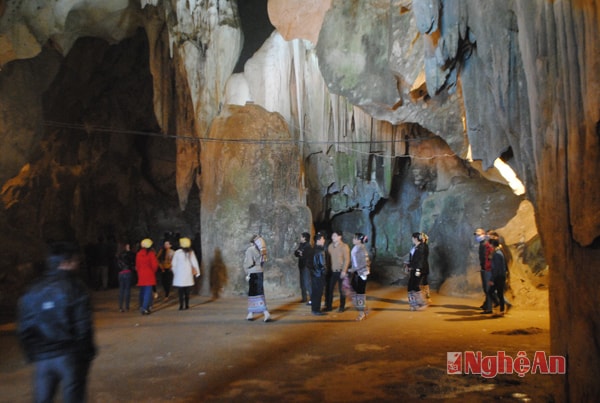The Wonders of the Deep
(Baonghean) -Tham Om in Chau Thuan commune, Quy Chau district is one of the most important archaeological sites in Vietnam, the first place where fossilized teeth of apes, accompanied by labor tools, were discovered.
The cave was surveyed by two French geologists and archaeologists, E. Saurin and M. Colani, in the 1930s (20th century). In 1973, it was explored by Vietnamese archaeologists and then excavated in 1975. Archaeologists found here saber elephant teeth, bear teeth, fossilized tooth remains of apes in the final stages of evolution into modern humans and other primitive stone tools and rare artifacts. This proved the continuous existence of humans on the land of Khe Chai, Khe Ninh (Chau Thuan) from the Paleolithic era (25,000 years ago) until now.
 |
| Deep Cave. |
Tham Om in Thai (indigenous people) means "Big Cave". According to historical documents, during the 10 years of Lam Son uprising against the invading Ming army, King Le Loi brought troops here many times to build a base and Tham Om and Tham Chang (nearby) were the gathering and garrisoning places for troops. The information from the above historical documents is highly reliable, because Tham Om itself is a very wide and long cave, the cave mouth is located at a high position, halfway up Tham mountain, so you can easily observe the surroundings, the cave is deep, like a corridor through this limestone mountain and leading to another cave called Ton That. The deeper the cave goes, the darker it gets, the people around the area often have to light torches when going to get firewood, dragging bamboo from one side to the other.
In the 90s of the 20th century, when the lives of local people were still difficult and their awareness of heritage protection was still weak, some people came to Tham Om to dig for red stones, but because they could not find precious stones or valuable antiques on the market, they quickly withdrew. However, a few years later, Tham Om and some other caves in the area were still destroyed by human hands. Some people came to Tham Om to saw and dig up the strangely shaped rocks in the cave to bring back to decorate and make feng shui stones in campuses and villas. Only when the local government intervened did the above situation end.
However, Tham Om is still a very beautiful landscape, attracting many domestic and foreign tourists to visit and do scientific research every year. The cave is high, airy and spacious. The deeper you go, the wider the cave becomes, divided into many branches and niches, creating a maze. The ceiling of the cave is filled with countless stalactites, surrounded by layers of red and yellow sediments, creating a majestic and magical beauty. Going deeper, there are many underground and open streams flowing through, creating smooth, flat sandbanks. Tham Om is not cold but warm with human breath. Many young men and women in the area have used this place as a place to date, make love, vow to marry, and build a hundred-year happiness.
Currently, along with other sites in the region such as Tham Chang, Tham Bua, Tham Ton That, Tham Om are being protected and preserved by the people and local authorities, and now there is a road system leading to the site. In 2009, the Department of Culture and Information advised the District People's Committee to submit to the Provincial Monuments and Landscapes Management Board for consideration and appraisal to submit to the Provincial People's Committee to rank Tham Om relic... Currently, Quy Chau district has planned the above cave complex to promote tourism development. Hopefully in the future, with more investment from the State, businesses and people, Tham Om will be better protected, promoting its existing values; the myths and legends associated with the land and people of this ancient Muong Chieng Ngam will revive...
Thanh Son






